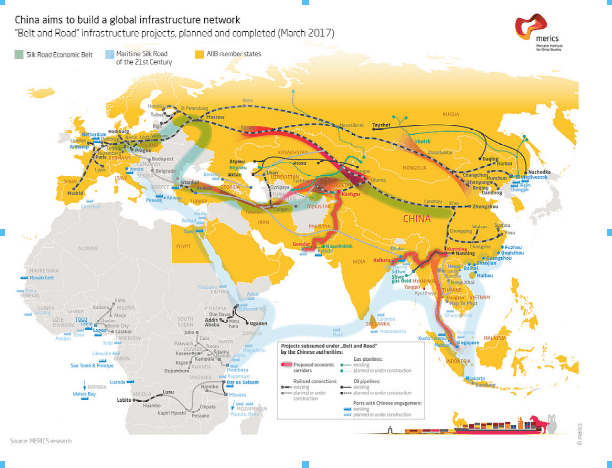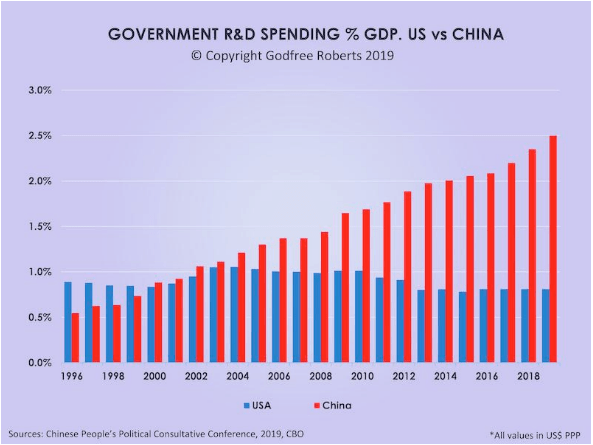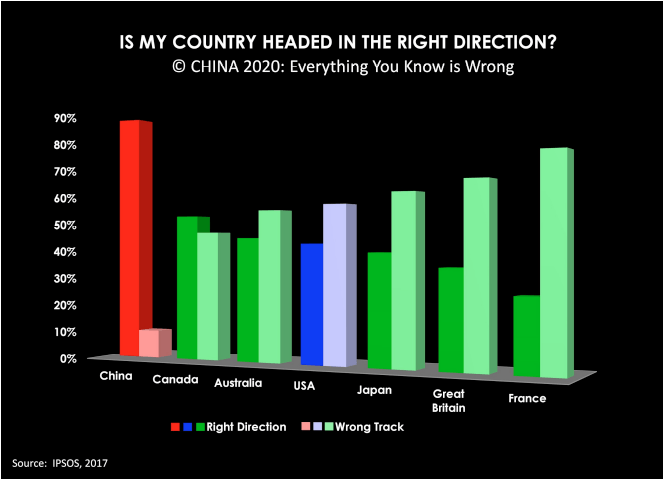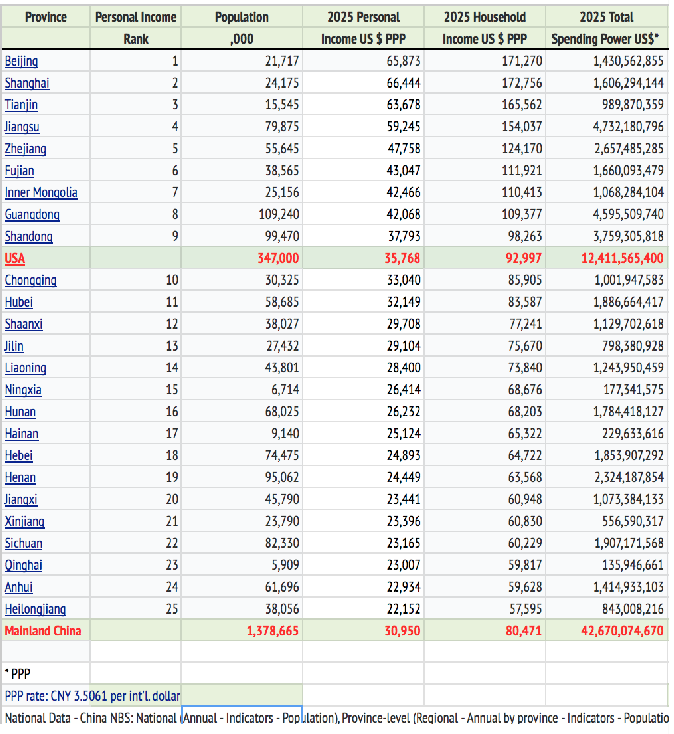SHOULD WE COMPETE WITH CHINA?

Godfree Roberts
Can We?
[dropcap]I[/dropcap]n 2003 I published a book charting America’s decline in thirty-six social and economic indicators. I mailed copies to the Administration, Congress and department heads and received one reply, from the Director General of the Central Intelligence Agency, saying that the Agency had been providing almost identical information to the government for decades. Since then our decline and China’s rise have both accelerated and momentum has carried us so far so quickly that competing with China has become unrealistic. No Wheels Magnetic Levitation Train
*** If China resembled the caricature our media has been drawing for the past seven decades then yes, we should compete with her repressive, extractive, authoritarianism and invest in advanced technologies to ensure that we remain the envy of the world. But what if China is neither repressive, extractive nor authoritarian? What if we have no bounty to invest? What if Chinese leaders are more popular, respected and competent than ours? What if her economy is thirty percent bigger and growing three times faster, with one-third the debt burden? What if she is already ahead of us scientifically and technologically, is militarily impregnable and possesses more–and more powerful–allies than we do? What should we do then? Here’s an inventory of where things stand: Government: Confucius, the supreme political scientist said, “If people have no faith in their rulers then the state cannot exist.” Our trust in government is at its lowest ebb in history. Gallup says most of us rank government as our most pressing problem and just 54 percent of us even ‘consistently express a pro-democratic position.’ China’s system of professional, non-factional government has returned it to its role as the Central Kingdom. Compared to ours, it is forward-looking, decentralized, efficient and thrifty. The Government Entrance Examination selects the top 2% of graduates each year and success is the only avenue to power and responsibility. The 200 members of the State Council–all promoted on their ability to work cooperatively–have collectively governed billions of people for a combined 5,000 years and their publicly available stats are jaw-dropping. Most have a PhD and an IQ over 140. All began their careers in the country’s poorest villages which they left only after raising average incomes by 50%. They repeated that performance at every level, and Xi is repeating it as President. Leadership. We choose leaders by acclamation–a Greco-Roman custom favoring eloquent rascals–and that is exactly what we get. While, as President Trump observed, “China’s leaders are much smarter than ours. It’s like taking the New England Patriots and Tom Brady and having them play your high school football team.” Economies. Today, China generates 20% of global GDP vs. our 15%. Its imports and exports are in balance, its trading relationships are excellent, its currency fairly valued, its economy one third larger and growing three times faster, its manufacturing wages at parity with ours and its plans for 2025 are breathtaking. Finances. The Financial Times says, “America will need to sell $12 Trillion of bonds in the coming decade..Who on earth–or in global finance–will buy this looming mountain of Treasuries, the US borrowing requirement even before Trump’s major upgrade of America’s weapons systems? ..These borrowing needs [will all] have to be financed in the context of already high global dollar debt exposure. One of America’s biggest hedge funds privately concluded that in five years’ time the Treasury will need to sell bonds equivalent to 25 percent of gross domestic product, up from 15 per cent now. This level of debt has occurred just twice in the past 120 years, first during the second world war and then again during the 2008 financial crisis”. Russia and China have no foreign debt, and China has abundant savings and carries a debt burden one-third America’s or the EU’s. Infrastructure: New highways, railways, subways and ports and, next year, entire cities built around blazing fast 5G integrated into everything from traffic management to materials processing. Geopolitics. In 2018, China’s 34% world approval rating beat America’s 31%. Gallup says, “As the global balance of soft power continues to shift, it may prove even more difficult for the US to counter this influence.” The Chinese are focusing their attention on Eurasia and, Zbigniew Brzezinski1 warned, “Control over Eurasia would almost automatically entail Africa’s subordination, rendering the Western Hemisphere and Oceania (Australia) geopolitically peripheral to the world’s central continent. Seventy-five percent of the world’s people live in Eurasia and most of the world’s physical wealth is there too, both in its enterprises and underneath its soil. Eurasia accounts for about three-fourths of the world’s known energy resources.” We ceded control of Crimea and the Black Sea to Russia and, increasingly, the Middle East, too. With the Belt and Road, China and Russia are amalgamating The Eurasian Economic Union (Armenia, Belarus, Kazakhstan, the Kyrgyz Republic and Russia with Tajikistan, Uzbekistan and Moldova in consideration); The Shanghai Cooperative Organization, SCO (Russia, Kazakhstan, Kyrgyzstan, Tajikistan, Uzbekistan, India, China, and Pakistan; with Afghanistan, Iran, Mongolia and Belarus as observers and Armenia, Azerbaijan, Cambodia, Nepal, Sri Lanka and Turkey as dialog partners); and the Regional Comprehensive Economic Partnership, RCEP (Brunei, Cambodia, Indonesia, Laos, Malaysia, Myanmar, the Philippines, Singapore, Thailand, Vietnam, China, Japan, India, South Korea, Australia and New Zealand). Once the Nord Stream II and South Stream pipelines are completed in December, how can the EU resist joining them? Science. The Chinese have a five IQ point advantage over us, which means that they have 300,000 people with 160 IQ, compared to 30,000 in the West. China has overtaken the US to become the world’s largest producer of scientific research papers, making up almost a fifth of the total global output and dominates the global ranking of the most-cited research papers published in the 30 hottest technology fields. Though the U.S. accounted for 3.9 million research papers overall, compared with 2.9 million from China, they produced the largest share in 23 of the 30 fields that drew the most interest, while we took the crown for the remaining seven. China is the most influential country in four of eight core scientific fields, ranking first in computer science, mathematics, materials science and engineering and is rapidly catching up in physics. The U.S. led in physics, environmental and earth sciences, basic life science and clinical medicine. Twenty years ago Samuel Huntington2 said, “Civilizations grow because they have an instrument of expansion, a military, religious, political, or economic organization that accumulates surplus and invests it in productive innovations and they decline when they stop the application of surplus to new ways of doing things. In modern terms we say that the rate of investment decreases. This happens because the social groups controlling the surplus have a vested interest in using it for non-productive but ego-satisfying purposes which distribute the surpluses to consumption but do not provide more effective methods of production.” As we can infer from the chart, the social groups controlling our surplus used it for non-productive, ego-satisfying purposes which distributed the surpluses to consumption but did not provide more effective methods of production. Technology. Two thirds of the world’s fastest computers are Chinese but nothing reveals the emptiness of our IP closet more than Chinese dominance of enhanced mobile broadband. We will take twice as long and spend twice as much integrating a less affordable, functional, compatible, upgradeable system, yet our feckless media derided President Trump when he called for America to dominate 6G, despite the publicly known fact that Huawei has had 600 mathematicians, physicists and engineers working on 6G for over a year. China leads the world in basic research and in most technologies, especially hot areas–like battery research–and accounted for more than seventy percent of all papers on photocatalysts and nucleic-acid-targeted cancer treatment, which ranked 12th and 14th. The US led in three biotechnology fields, including #7 genome editing and #10 immunotherapy. China also leads in all fields of civil engineering and of sustainable and renewable energy, in manufacturing, supercomputing, speech recognition, graphenics, thorium power, pebble bed reactors, genomics, thermal power, ASW missiles, drones, in-orbit satellite refueling, passive array radar, metamaterials, hyperspectral imaging, nanotechnology, UHV electricity transmission, HSR, speech recognition, radio-telescopy, hypersonic weapons, satellite quantum communications, quantum secure direct communications and quantum controls. “Approximately 72% of the academic patent families published in QIT since 2012 have been from Chinese universities. US universities are a distant second with 12%.”
Trade. Midway in the sixteenth century China became the great repository of the early modern world's newly discovered wealth in silver. Long a participant in international maritime trade, China experienced the consequences of the greatly enlarged patterns in world trade. In that commerce China was essentially a seller of high-quality craft manufactures. Other countries could not compete either in quality or price. The colonies of the New World and the entire Mediterranean sphere of trade, from Portugal and Spain to the Ottoman Empire, began to complain that the influx of Chinese goods undermined their economies3. China’s most significant trade relationships are with Asia and Europe, with the US third. As Parag Khanna4 says, Beijing must wonder why #3 would launch a trade war against #1. Though we are self-sufficient in many things,we may be more dispensable than we imagine. ‘America first’ sounds great except when it actually means ‘America alone’. Social Indicators: Rulers who led their people to the Realm of Lesser Prosperity, a xiaokang[1] lifestyle, were themselves pillars of courtesy, sincerity, justice and virtue while those who did not lost power and everyone regarded them as pests. Ninety-eight percent of Chinese listed as ‘poor’ already own their homes and Xi has scheduled 2021-2035 to bringing GINI below Finland’s. China’s GINI, which never reached our nosebleed levels, is dropping like a stone and extreme poverty will be gone next year, when every Chinese will have a home, a job, plenty of food, education, safe streets, health and old age care (there will then be more drug addicts, suicides and executions, more homeless, poor, hungry and imprisoned people in America than in China). 500,000,000 urban Chinese will have more net worth and disposable income than the average American, their mothers and infants will be less likely to die in childbirth, their children will graduate from high school three years ahead of–and outlive–our kids. Education: No country has so many intelligent, well trained, devoted engineers. One-fourth of the world’s STEM workers are Chinese, an intellectual workforce eight times larger, growing six times faster and graduating high school students three years ahead of ours. By 2025, China will have more technologically skilled workers than the entire OECD–the US, EU, Canada, Mexico, Australia, Israel, Japan, Korea, New Zealand, and Turkey–combined. Low crime, no religious nonsense or Islamic violence. Companies can invest safely without fear of religious unrest, violence or robbery. Faith in the future, nationalism, a belief in building a better China: the Chinese have a strong belief in the future and willingly sacrifice time and effort for the next generation. The Chinese are feeling as we did in the 60s, except that their wages and wealth have doubled every decade for seventy years. Their Market: There are twice as many people in China than in the US and Europe combined and domestic consumption of China is growing 7% annually thanks to 200 million rural people moving into new cities. China will have abundant low salary workers in its western provinces for the next 15 years. Chinese companies are flexible beyond imagination. They can change products, management, focus, or whatever, literally overnight. The Chinese are incredibly flexible and their culture has already outlived the Egyptians, the Greeks and the Romans. Western companies are hierarchically organised whereas in Chinese companies decisions are made fast, often on the phone. Politics. China is the world’s leading democracy. Though this claim enrages many Westerners, regardless of the metric employed, electively, popularly, procedurally, operationally, substantively, financially, and technologically, China is a thriving democracy and America is not. Defense. The PLA fields some of the most modern weapon systems in the world at half the cost of America’s defense budget. Its more modern missiles outrange ours in every weight and class thanks to the tight coupling between their world leading chemists and rocket propellent manufacturers. Russian weapons systems fill any gaps. Morale. A highly cohesive society, 95% support their government’s policies and most are willing to fight for their country. The Future. By 2025, nine provinces will enjoy higher average incomes than the US. By 2040, all will. |
1The Grand Chessboard
2Clash of Civilizations and the Remaking of the World Order, Samuel Huntington
3F.W. Mote, Imperial China 900-1800.
4The Future is Asian: Commerce, Conflict, and Culture in the 21st Century
 Godfree Roberts was born in Australia and educated in the US, where he received his doctorate from UMass, Amherst. He lost his first job in 1961 for defending China's resumption of sovereignty over Tibet. He still annoys authorities by pointing out that the Chinese government has kept all its promises for the past 70 years while our government has broken them all. His book, How China Works, is forthcoming.
Godfree Roberts was born in Australia and educated in the US, where he received his doctorate from UMass, Amherst. He lost his first job in 1961 for defending China's resumption of sovereignty over Tibet. He still annoys authorities by pointing out that the Chinese government has kept all its promises for the past 70 years while our government has broken them all. His book, How China Works, is forthcoming.
[premium_newsticker id="154171"]
This work is licensed under a Creative Commons Attribution-NonCommercial 4.0 International License.







